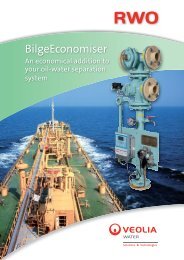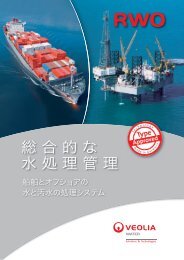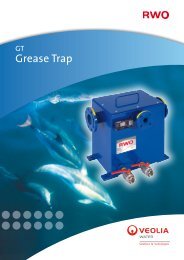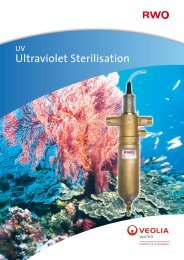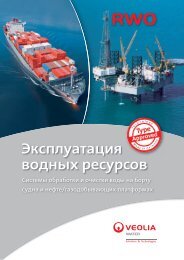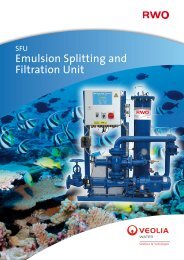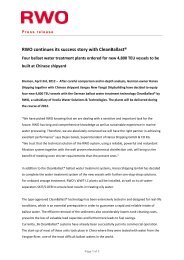the IHS Ballast Water Guide - RWO Marine Water Technology
the IHS Ballast Water Guide - RWO Marine Water Technology
the IHS Ballast Water Guide - RWO Marine Water Technology
You also want an ePaper? Increase the reach of your titles
YUMPU automatically turns print PDFs into web optimized ePapers that Google loves.
Sponsored by <strong>IHS</strong> Fairplay Solutions <strong>Guide</strong> to <strong>Ballast</strong> <strong>Water</strong> Treatment Systems<br />
Development in USA keeps in STEP<br />
The Shipboard <strong>Technology</strong> Evaluation Program (STEP) is a USCG initiative aimed at encouraging <strong>the</strong><br />
development of treatment systems and shipboard testing. In <strong>the</strong> words of <strong>the</strong> USCG, STEP facilitates<br />
“…<strong>the</strong> development of effective ballast water treatment technologies, through experimental systems,<br />
thus creating more options for vessel owners seeking alternatives to ballast water exchange”.<br />
The STEP programme offers incentives to vessels for engaging in <strong>the</strong> development and use of<br />
experimental treatment technologies. A vessel accepted into STEP prior to USCG ballast water discharge<br />
standards being decided will be considered to have an equivalent ballast water management<br />
practice in compliance with federal regulations for <strong>the</strong> life of <strong>the</strong> treatment equipment or <strong>the</strong> life of <strong>the</strong><br />
vessel, whichever is shorter.<br />
Vessels accepted to STEP after <strong>the</strong> establishment of discharge standards will be granted equivalency<br />
status to <strong>the</strong> ballast water discharge standards for 10 years.<br />
water suffi ciently, environmental groups<br />
concerned over invasive species sued <strong>the</strong><br />
EPA. A settlement that was confi rmed on 8<br />
March 2011 stipulated that <strong>the</strong> new VGP,<br />
which enters force in January 2014, “will<br />
include concentration-based effl uent limits<br />
for discharges of ballast water expressed as<br />
organisms per unit”.<br />
In February 2012, New York State dropped<br />
plans for a ballast treatment rule that was<br />
deemed unrealistic by shipowners and<br />
manufacturers alike and could have closed<br />
<strong>the</strong> St Lawrence Seaway and <strong>the</strong> Port of New<br />
York-New Jersey to most shipping.<br />
USCG Commissioner Joe Martens of <strong>the</strong><br />
New York Department of Environmental<br />
Conservation said on 23 February <strong>the</strong> state<br />
will support a national ballast regulation<br />
standard being advanced by <strong>the</strong> EPA.<br />
The Canadian government welcomed<br />
New York’s announcement and agreed that<br />
uniform standards are <strong>the</strong> best way to protect<br />
<strong>the</strong> marine environment.<br />
Late in March <strong>the</strong> USCG published a new<br />
fi nal ruling on ballast water treatment that<br />
recognises that <strong>the</strong> construction dates in <strong>the</strong><br />
initial Phase 1 rules have now passed and has<br />
amended <strong>the</strong> implementation requirement<br />
accordingly. However, <strong>the</strong> compliance date for<br />
ships remains eff ectively unaltered.<br />
This means that new vessels built after<br />
1 December 2013 must have a functioning<br />
approved system on board and vessels built<br />
before that date with a ballast capacity<br />
between 1,500m 3 and 5,000m 3 will be<br />
required to fi t one at <strong>the</strong> fi rst drydocking<br />
after 1 January 2014. O<strong>the</strong>r sizes of existing<br />
vessels have two years beyond that to comply.<br />
The new rule also postpones indefi nitely<br />
<strong>the</strong> controversial Phase 2 standards on<br />
<strong>the</strong> grounds that independent scientifi c<br />
advice has shown that <strong>the</strong>y are currently<br />
unachievable. Higher standards have not been<br />
entirely abandoned, as <strong>the</strong> rule allows for <strong>the</strong><br />
existing Phase 2 or o<strong>the</strong>r standards in excess<br />
of <strong>the</strong> Phase 1 (IMO equivalent) limits to be<br />
introduced at a future date.<br />
Whe<strong>the</strong>r that happens will depend on<br />
<strong>the</strong> performance standards that treatment<br />
systems are able to achieve. In order to decide,<br />
regular reviews of <strong>the</strong> commercial systems<br />
and developing technologies will take place.<br />
© <strong>IHS</strong> Global Limited 2012 9<br />
006_009_BW1204.indd 9 21/03/2012 18:28:31



